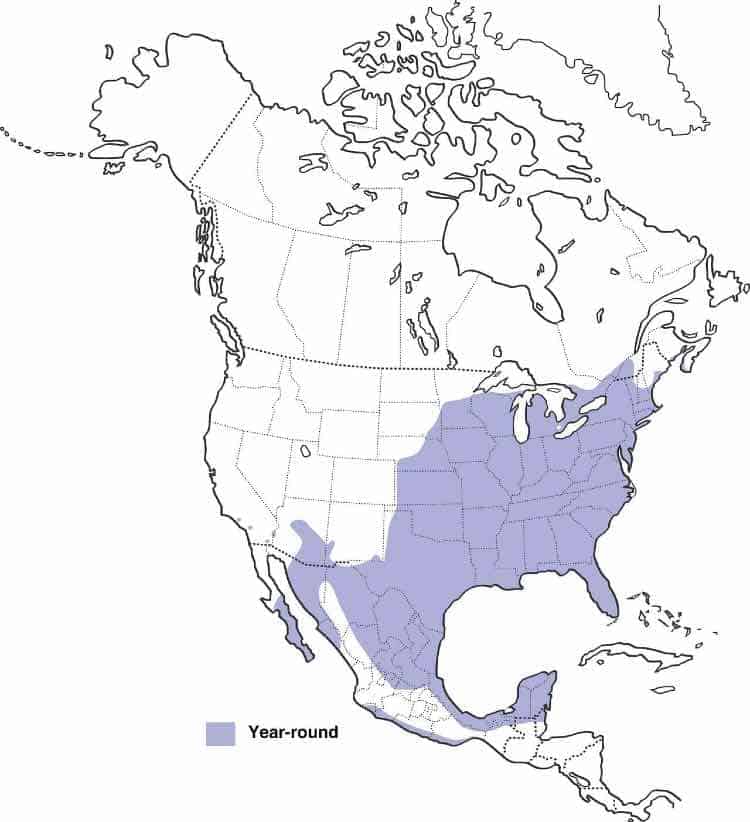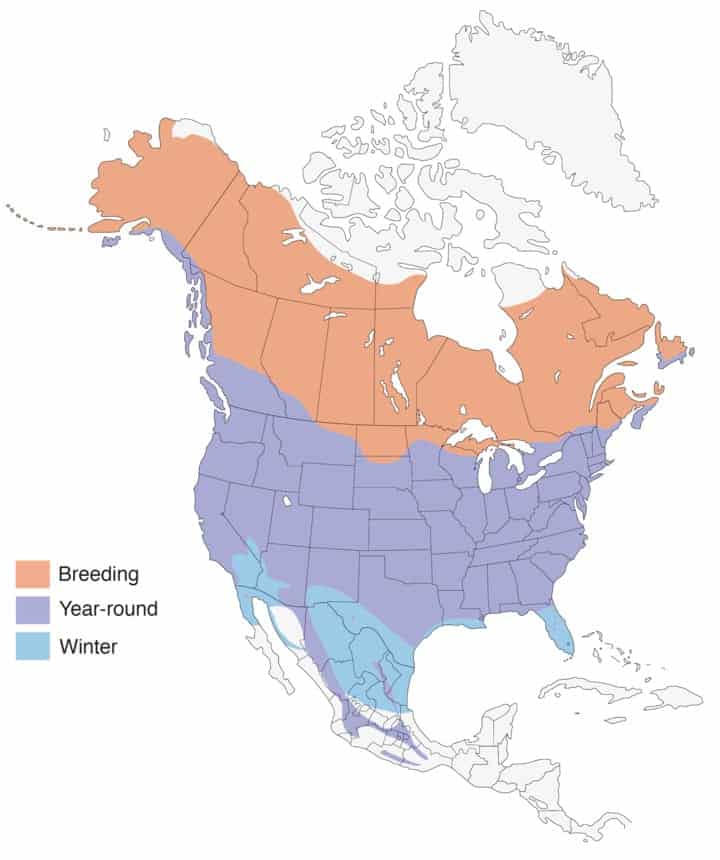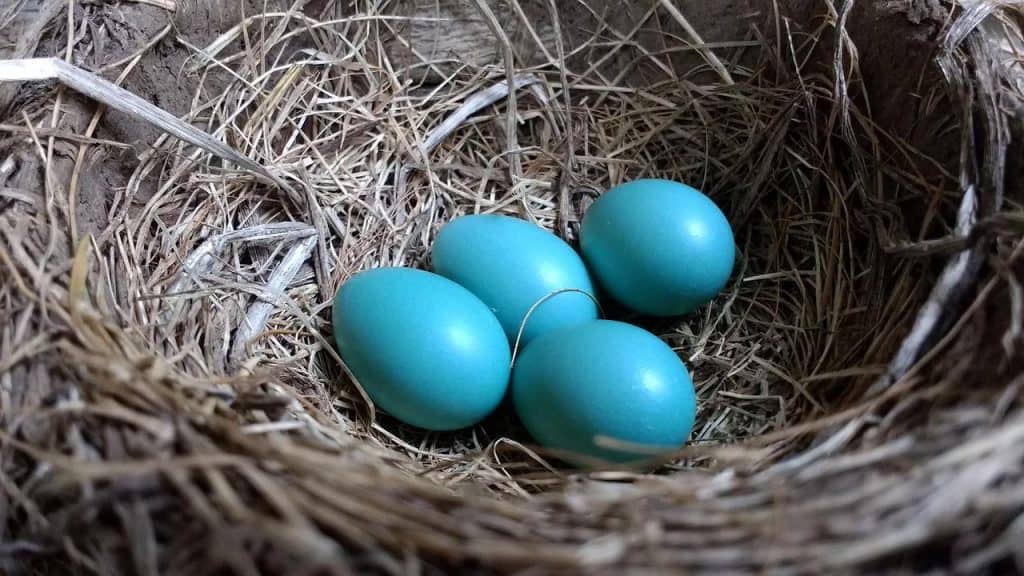Cardinal and robin differences are obvious and many. They’re two different bird species with very little in common. I put these two birds head-to-head and studied their appearances, behaviors, and habits. The result? A tidy list of 16 key differences between them.
Here are the 16 key differences between northern cardinals and American robins:
- Male & Female Coloration
- Size
- Appearance
- Range
- Diet
- Sounds
- Female Singers
- Movement
- Territories
- Nest Location
- Eggs
- Life Mates
- Migration
- Lifespan
- Family Group
- Backyard Visitors
1. Cardinal vs Robin Male & Female Coloration
Male and female cardinals have different coloring while male and female robins have the same coloring.
Cardinals are an example of sexual dichromatism which is a fancy term for male and female have different colors. The male cardinal is bright red and the female cardinal buffy brown with tinges of red.

The male and female robin are both brown/gray above, orange beak, black round head, and rust-orange breast (the female’s chest is slightly paler).


2. Cardinal vs Robin Size
Northern cardinals and American robins are different sizes. Robins are bigger. Robins are about 10” long and cardinals about 8 ¾” long.
An inch and a quarter may not see like much to humans but in the bird world – it’s a big deal!
3. Cardinal vs Robin Appearance


The biggest difference between cardinals and robins is their appearance. There are numerous physical attributes that set the two species apart including the plumage (feather colors), crown, beak, eyes, and belly.
Let’s take a look.
Plumage (Feather colors)
The biggest difference between cardinals and robins is their feather coloration, or plumage. In fact, they couldn’t be more different.
The male cardinal is bright red with a black face and the female is buffy brown with a charcoal face.
The robin has a black head, gray-brown back, wings & tail with a rust-orange breast and belly.
Ever heard the phrase “robin red-breast”?
The American Robin was originally named robin red-breast. This seems odd to me since its breast is more orange than red.
Crown (Crest)
Cardinals have crowns (or crests) that stand tall on the top of their heads. This gives the appearance of a triangle-shaped head. The male’s crown is bright red and the female’s is buffy-brown with tinges of red.
Robins have black, round heads with no crown.
Beak
Cardinals have a short, stubby, orange beak.
Robins have a long, pointy, yellow bill.
Eyes
Cardinals have round, black eyes.
Robins have round, black eyes with white strips above and below each eye.
Belly
Robins have a round, orange belly.
Cardinals have a more oval shaped belly. The male’s belly is red, the female’s is buffy brown.
4. Range
Cardinals and robins both live in North America and enjoy similar habitats, but have different size ranges.
Cardinal Range

Robin Range

Northern cardinals only live in the eastern part of the U.S.
American robins have a much larger range, including nearly the entire continent. Robins live in the U.S., Canada, and Mexico.
5. Cardinal vs Robin Diet
Cardinals and robins have different diets.
Cardinals mostly eat seeds, and fruits. Their beaks are specifically intended for cracking seeds like sunflowers to get at the good stuff inside. The outside is a short and sturdy triangular shape that provides the right amount of leverage to crack the seed shells. The inside xxx.

Cardinals supplement their diet with insects, earthworms and other invertebrates (especially when feeding their babies in spring & summer) but they don’t consume nearly as much insects as they do seeds and fruit.
Robins primarily eat insects, worms and other invertebrates. They also supplement their diet with fruits. Notice the robin’s beak. It’s long and slender, ideal for digging up backyard worms, clamping them in the beak and eating (nom nom).

Since they also eat fruit, their beak design is just the right length that when opened creates the perfect tool for plucking berries off the branch. You will never find a robin chomping on seeds – their beak couldn’t support that activity very well.
You may see a cardinal snacking on a worm but more than likely you’d catch them cracking open a sunflower seed.
6. Cardinal vs Robin Sounds
Cardinal’s and robin’s sounds are easy to tell apart. Both have a distinctive song and call.
I could try to spell out the sound but how useful would that be?
Click the sounds below and listen for the difference. Audios are compliments of the Macaulay Library.
Northern Cardinal Song & Call
American Robin Song & Call
7. Cardinal vs Robin Female Singers
The female cardinal sings while the female robin does not.
To be fair, it’s unusual for the female of the species to sing. While the females make other sounds and calls, the male is usually the singer in the family. The cardinal family is an exception.
8. Movement
Cardinals are ground foragers so are commonly seen moving about the ground. They hop from one spot to the next.
Robins spend a lot of time on the ground too – looking for earthworms. They take a few swift steps then abruptly stop and look around.
9. Cardinal vs Robin Territories
Cardinals and robins establish territories during the mating season but they are very different in size.
The cardinal’s territory is anywhere from ½ acre to 6 acres.
The robin’s territory is usually less than an ½ acre, and they often overlap.
10. Cardinal vs Robin Nest Location
Cardinals always place their nest in a dense tree or shrub. The height depends on which brood in the season (1st, 2nd, 3rd) with subsequent broods’ nests placed higher than the previous.
Robins place their nest in a variety of places, including in a tree or shrub. They’ve been known to establish a nesting site in these locations:
- A shrub or tree
- Gutter of a house
- On the ground
- Nesting shelf
- Within an overhang
11. Cardinal vs Robin Eggs
Cardinals and robins have completely different color eggs.
Cardinal Eggs

Cardinals eggs are either light gray, light green, or ivory with gray or brown specs
Robin’s eggs are bright sky blue or blue-green, without spots.
12. Cardinal vs Robin as Life Mates
Cardinals and robins are both monogamous. Meaning, each pair remains with its partner during the mating season.
Cardinals take it a step further and are generally considered to mate for life. The pair will get back together each spring to breed and raise another set of young.
Robins on the other hand do not mate for life. Once the breeding season is over there’s no expectation they’ll pair back up next spring. It does happen, but it’s the exception, not the rule.
13. Cardinal vs Robin Migration
Cardinals do not migrate but robins do.
Cardinals remain in their year-round range (eastern U.S.) all months of the year. They mate, nest, raise young, prepare for winter, and spend winter in the same range all months of the year.
Robins also have a year-round range where a population of the species remains all months of the year. However, many of them do migrate. In spring they head north into Alaska and Canada for breeding. In the fall they head south, some as far south as Mexico to spend the winter.
14. Cardinal vs Robin Lifespan
Cardinals live for about 3-5 years.
Robins only live for an average of two years.
15. Cardinal vs Robin Family Group
Northern cardinals and American robins belong to different family groups. This further highlights that the two birds are more different than similar since families are categorized based on physiological and genetic similarities.
Cardinals belong to the Cardinalidae family.
American robins belong to the Turdidae family.
16. Cardinal vs Robin Backyard Visitors
Cardinals and robins are common backyard visitors – but in different ways.
Cardinals will visit a bird feeder and munch down on the birdseed. Robins do not visit bird feeders (unless you fill them with juicy worms!).
Instead, robins will hop around your yards and gardens in search of insects and other tasty invertebrates.
Overview of Cardinal vs Robin
The table below summarizes the obvious differences between the northern cardinal and American robin.
| Cardinal | Robin | |
|---|---|---|
| 1. Male/Female Coloration | Male and female cardinals have different colors | Male and female robins have the same colors |
| 2. Size | Cardinals are smaller (8 3/4″) | Robins are larger (10″) |
| 3. Appearance | Cardinals are red (male) with a crown, black mask, orange stubby beak, and oval breast. (Female is same as male except buffy-brown with a charcoal mask). | Robins are grayish/brown with a black and round head, no crown, yellow long beak, and large round rust-orange breast. |
| 4. Range | The cardinal range is the eastern U.S. | The robin range is nearly the entire North American continent |
| 5. Diet | Cardinals primarily eat seeds | Robins primarily eat insects and worms |
| 6. Sounds | Cardinal songs and calls are distinctly different than robins | Robin songs and calls are distinctly different than cardinals |
| 7. Female Singers | Female cardinals sing | Female robins don’t sing |
| 8. Movement | Cardinals hop | Robins run and stop |
| 9. Territories | Cardinal territories are larger – 1/2 – 6 acres | Robin territories are smaller – about 1/2 acre |
| 10. Nest Location | Cardinal nests are inside thick shrubs. | Robin nests can be anywhere including but not limited to in a shrub |
| 11. Eggs | Cardinal eggs are light gray, light green, or ivory with gray or brown specs | Robin eggs are blue with no specks |
| 12. Life Mates | Cardinals mate for life | Robins do not mate for life |
| 13. Migration | Cardinals do not migrate | Robins do migrate |
| 14. Lifespan | Cardinals live 3-5 years | Robins live 2 years |
| 15. Family Group | Cardinalidae | Turdidae |
| 16. Backyard Visitors | Cardinals visit backyards and feeders | Robins visit backyards but not feeders. |
Conclusion
Northern cardinals and American robins are two very different bird species. They’re even in different bird families.
If that’s not enough, consider the biggest differentiator: their appearance.
The plumage between these two birds are vastly different as well as the crown/no crown, beak, eyes, and belly shape.
Robins also have a larger range which means more people get to see this bird than the cardinal.
They have different diets, move about differently, and lay different colored eggs.





